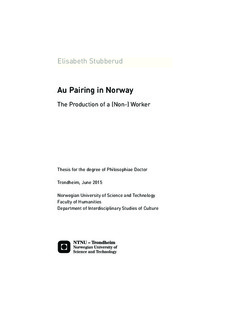| dc.description.abstract | This thesis looks at au pairing in contemporary Norway. Norway has gone from being a sending country to a receiving country of au pairs over the past 20-25 years. Public understanding of the scheme has changed accordingly, from an au pair to a host perspective. The notion of au pairing as ‘cultural exchange’ rather than work migration has persisted through this shift, and serves as a cultural and legal legitimisation for the current practice of hiring affordable live-in domestic workers in Norway. Consequently, the domestic work and carework au pairs do is not acknowledged as work, with the lack of rights that entails.
The thesis critically investigates the domestic labour and affective boundary work au pairing entails, possibilities of migration and citizenship through au pairing, and the cultural representations and cultural conditions of au pairing in Norway. Through interviews with au pairs and participant observation in the homes where they work, as well as analysis of documentary films, the following questions are investigated: How do au pairs understand au pairing? How does the figure of the au pair get produced in Norwegian media representations? How is au pairing constituted simultaneously as work and non-work? What forms does agency take for au pairs? Which processes of marginalisation, inclusion and exclusion become active in producing au pairing and the figure of the au pair?
The dissertation includes three academic articles and a synthesising chapter. The first article, ‘’It’s not much’. Affective (boundary) work in the au pair scheme’, argues that affective labour and boundary work are part of the domestic and carework au pairs do in their host families’ home. Drawing on interviews with current and former au pairs, the article investigates the statement ‘it’s not much’ as a way of affectively negating the extent or the drudgery of live-in domestic work.
The second article, ‘From intimate relations to citizenship? Au pairing and the potential for (straight) citizenship in Norway’ looks at the possibilities for formal and informal citizenship through intimate relations in the au pair scheme. Through au pairs’ narratives of dating, the article argues that while citizenship can be performed culturally and relationally as well as gained formally, there is a sense of cruel optimism to the prospect of au pairing as a migration route where au pairs have individual agency, as migration is always governed from above.
The third article, ‘Framing the au pair. Problems of sex, work and motherhood in Norwegian au pair documentaries’ analyses two television documentaries about au pairs in Norway. It argues that au pairs are naturalised as vulnerable, yet sexually available Filipina women, who are also poor enough to do the labour under the present conditions. In doing this, the films also carve out a space to argue that au pairs from the global south should be outlawed for their own good.
Read together, the three articles shed light on the ways in which various power structures intersect. By performing undervalued labour, traditionally done, unpaid, by women, au pairs get produced as a particular kind of migrant worker. The articles show how au pairs get marginalised when gender, class, race, ethnicity, sexuality, visa status, age, and religion intersect in the activity of paid domestic labour. | nb_NO |
